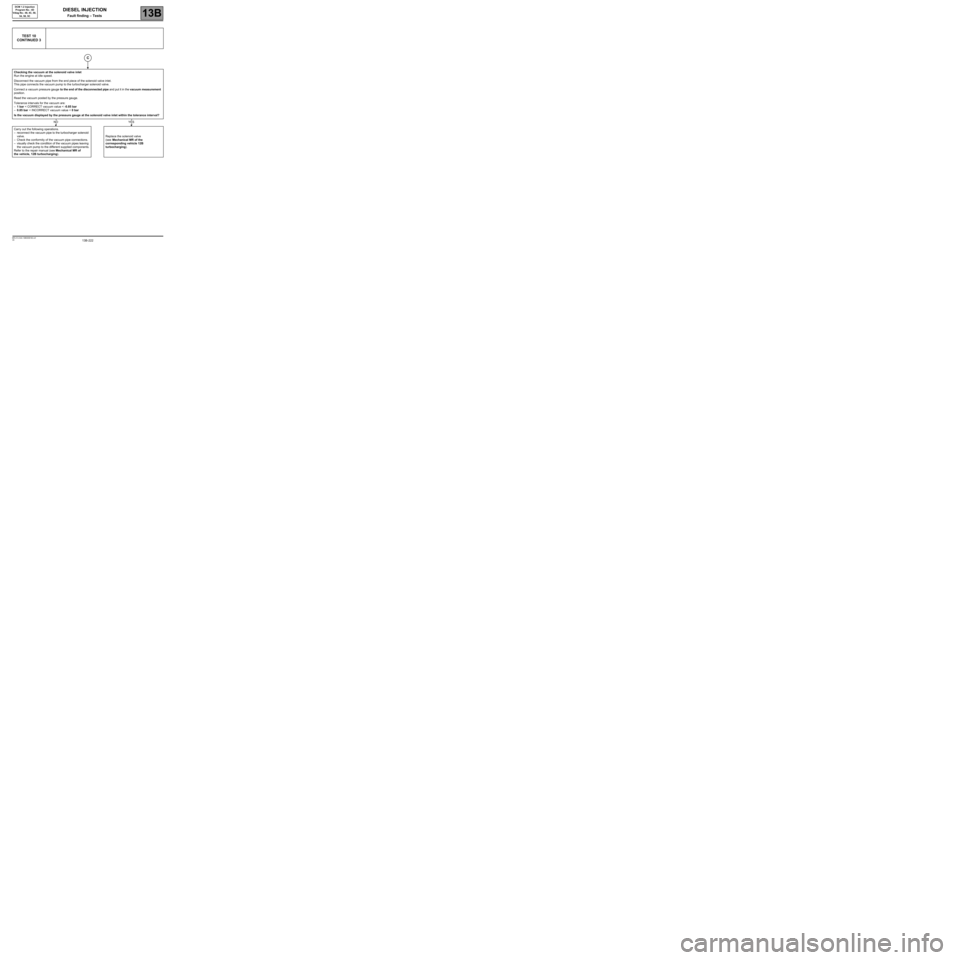Page 203 of 269
13B-203
AFTER REPAIRDeal with any faults displayed by the diagnostic tool. Clear the computer fault
memory.
Carry out a road test followed by another check with the diagnostic tool.
V6 MR-413-X44-13B000$170.mif
DIESEL INJECTION
Fault finding – Interpretation of parameters13B
DCM 1.2 Injection
Program No.: 4D
Vdiag No.: 54, 5C
PR932DEGREE OF ENGINE OIL DILUTION
PARAMETER
DEFINITIONThis parameter gives the value for the degree of oil wear in %.
NOTESThis parameter is not to be interpreted:
–on the K9K812 engine,
–if PR932 = 0 (Vdiag 58 only).
Conformity check: Engine stopped, ignition on or engine running.
PR932 = 0% for the first 900 miles (1500 km), beyond this value the PR932 changes regularly until it
reaches 100%.
If PR932 = 100% it means that the oil should be changed.
DCM1.2_V54_PR932/DCM1.2_V5C_PR932
Page 204 of 269
13B-204
AFTER REPAIRDeal with any faults displayed by the diagnostic tool. Clear the computer fault
memory.
Carry out a road test followed by another check with the diagnostic tool.
V6 MR-413-X44-13B000$170.mif
DIESEL INJECTION
Fault finding – Interpretation of parameters13B
DCM 1.2 Injection
Program No.: 4D
Vdiag No.: 54, 5C
PR1015OIL SERVICE INTERVAL
PARAMETER
DEFINITIONThis parameter indicates the vehicle distance before the next oil change in miles (km).
NOTES–This parameter is not to be interpreted:
–on the K9K812 engine,
–if PR1015 = 50000 (Vdiag 58 only).
Conformity check: Engine stopped, ignition on or engine running.
20000 km < PR1015 < 0 km.
This parameter decreases to 0 according to the vehicle distance and the degree of oil wear.
DCM1.2_V54_PR1015/DCM1.2_V5C_PR1015
Page 219 of 269

13B-219V6 MR-413-X44-13B000$190.mif
DIESEL INJECTION
Fault finding – Tests13B
DCM 1.2 Injection
Program No.: 4D
Vdiag No.: 48, 4C, 50,
54, 58, 5C
TEST 10 Turbocharger solenoid valve check
Note:
No turbocharger control solenoid valve present on the K9K 740 engine for New Twingo and the K9K 800
engine for Kangoo 2.
Checking the vacuum at the pressure regulator inlet
Run the engine at idle speed.
Check the engine temperature using the CLIP parameter PR064 Coolant temperature.
Let the engine warm up until the temperature reaches 80
°C.
Disconnect the vacuum pipe from the end piece of the pressure regulator.
Connect a vacuum pressure gauge to the end of the disconnected pipe and put it in the vacuum measurement
position.
Perform a quick acceleration by depressing the accelerator pedal completely and then releasing it immediately.
The total duration of pressing and holding in the full load position must not exceed 1 second.
During this acceleration, the engine speed must reach a value between 3000 and 4000 rpm.
Repeat the operation 3 times.
Read the maximum vacuum posted by the pressure gauge during the increase and decrease in the speed and after
the return to idle speed.
Tolerance intervals for the vacuum are:
–1 bar < CORRECT vacuum value < - 0.6 bar
–0.6 bar < INCORRECT vacuum value < 0 bar
Is the vacuum at the turbocharging pressure regulator inlet displayed on the vacuum gauge within
the tolerance interval?
The solenoid valve is in order.
NOYES
A
DCM1.2_V48_TEST10/DCM1.2_V4C_TEST10/DCM1.2_V50_TEST10/DCM1.2_V54_TEST10/DCM1.2_V58_TEST10/DCM1.2_V5C_TEST10
Page 220 of 269

13B-220V6 MR-413-X44-13B000$190.mif
DIESEL INJECTION
Fault finding – Tests13B
DCM 1.2 Injection
Program No.: 4D
Vdiag No.: 48, 4C, 50,
54, 58, 5C
TEST 10
CONTINUED 1
Reconnect the vacuum pipe on the turbocharging pressure regulator
Checking the vacuum at the solenoid valve outlet
Leave the engine running at idle speed.
Disconnect the vacuum pipe from the end piece of the solenoid valve outlet.
This pipe connects the solenoid valve to the turbocharging pressure regulator.
Connect a vacuum pressure gauge to the solenoid valve outlet and put it in the vacuum measurement position.
Perform a quick acceleration by depressing the accelerator pedal completely and then releasing it immediately.
The total duration of pressing and holding in the full load position must not exceed 1 second.
During this acceleration, the engine speed must reach a value between 3000 and 4000 rpm.
Repeat the operation 3 times.
Read the maximum vacuum posted by the pressure gauge during the increase and decrease in the speed and after
the return to idle speed.
Tolerance intervals for the vacuum are:
–1 bar < CORRECT vacuum value < - 0.6 bar
–0.6 bar < INCORRECT vacuum value < 0 bar
Is the vacuum displayed by the pressure gauge at the solenoid valve outlet within the tolerance interval?
Reconnect the vacuum pipe on
the turbocharging pressure regulator Replace the vacuum pipe between the solenoid valve
and the turbocharging pressure regulator (see
Mechanical MR of the vehicle, 12B turbocharging).
A
NOYES
B
Page 222 of 269

13B-222V6 MR-413-X44-13B000$190.mif
DIESEL INJECTION
Fault finding – Tests13B
DCM 1.2 Injection
Program No.: 4D
Vdiag No.: 48, 4C, 50,
54, 58, 5C
TEST 10
CONTINUED 3
Checking the vacuum at the solenoid valve inlet
Run the engine at idle speed.
Disconnect the vacuum pipe from the end piece of the solenoid valve inlet.
This pipe connects the vacuum pump to the turbocharger solenoid valve.
Connect a vacuum pressure gauge to the end of the disconnected pipe and put it in the vacuum measurement
position.
Read the vacuum posted by the pressure gauge.
Tolerance intervals for the vacuum are:
–1 bar < CORRECT vacuum value < -0.85 bar
–0.85 bar < INCORRECT vacuum value < 0 bar
Is the vacuum displayed by the pressure gauge at the solenoid valve inlet within the tolerance interval?
Carry out the following operations.
–reconnect the vacuum pipe to the turbocharger solenoid
valve.
–Check the conformity of the vacuum pipe connections.
–visually check the condition of the vacuum pipes leaving
the vacuum pump to the different supplied components.
Refer to the repair manual (see Mechanical MR of
the vehicle, 12B turbocharging).Replace the solenoid valve
(see Mechanical MR of the
corresponding vehicle 12B
turbocharging).
C
NOYES